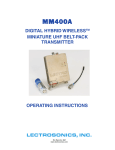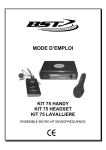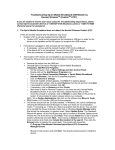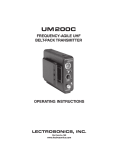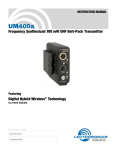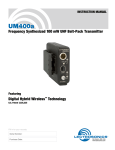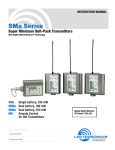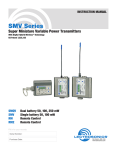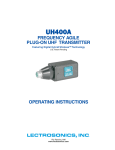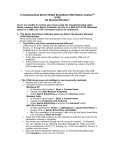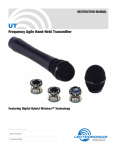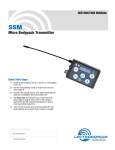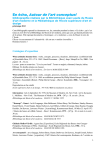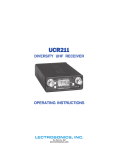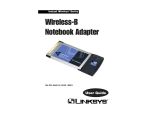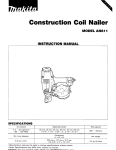Download Lectrosonics LM user manual
Transcript
LM FREQUENCY-AGILE UHF BELT-PACK TRANSMITTER Featuring Digital Hybrid Wireless™ Technology (US Patent Pending) OPERATING INSTRUCTIONS LECTROSONICS, INC. Rio Rancho, NM, USA www.lectrosonics.com LM 2 LECTROSONICS, INC. Frequency Agile UHF Belt-Pack Transmitter Thank you for selecting the Lectrosonics LM frequency agile, belt-pack transmitter. The design of the LM introduces the advanced technology and features of a classic Lectrosonics beltpack transmitter at a moderate cost. The unit is designed around the Digital Hybrid WirelessTM system (US Patent Pending) which combines a digital audio chain with an analog FM radio link. This digital process eliminates the compandor and it’s problems, yet preserves the extended operating range of the finest analog wireless systems. The LM also preserves your investment. The transmitter can emulate the compandor found in 100, 200 and IFB Series Lectrosonics receivers, and certain receivers from other manufacturers. (Call Lectrosonics for more details.) Changing the compatibility mode is accomplished with a simple procedure that does not require opening the unit. The mechanical assembly is a rugged, machined aluminum package with a removable, stainless steel wire belt clip. The input jack is a standard Lectrosonics 5-pin type for use with electret lavalier mics, dynamic mics and line level signals. LEDs are provided on the LM front panel to make quick and accurate level settings without having to view the receiver. The battery compartment accepts any 9 volt battery (alkaline or lithium recommended) and makes a positive connection via self-adjusting contacts. The antenna is a super-rugged, permanently attached 1/4 wavelength design made of flexible galvanized steel cable. Only the LM transmitter is covered in this manual. Companion receivers are covered in separate manuals. TABLE OF CONTENTS GENERAL TECHNICAL DESCRIPTION .......................................................................... 4 INTRODUCTION ........................................................................................................... 4 DIGITAL HYBRID TECHNOLOGY ................................................................................ 4 INPUT LIMITER ............................................................................................................ 5 NO PRE-EMPHASIS/DE-EMPHASIS ........................................................................... 5 PILOT TONE SQUELCH .............................................................................................. 5 WIDE-BAND DEVIATION .............................................................................................. 5 LONG BATTERY LIFE ................................................................................................... 5 FREQUENCY AGILITY ................................................................................................. 5 ANTENNA ..................................................................................................................... 5 CONTROLS AND FUNCTIONS ........................................................................................ 6 MIC ................................................................................................................................ 6 POWER ON/OFF SWITCH ........................................................................................... 6 POWER LED ................................................................................................................. 6 FREQUENCY SELECT SWITCHES ............................................................................. 6 MODULATION LEDS .................................................................................................... 7 AUDIO LEVEL ............................................................................................................... 7 ANTENNA ..................................................................................................................... 7 THE BELT CLIP ............................................................................................................. 7 BATTERY INSTALLATION ................................................................................................. 7 OPERATING INSTRUCTIONS .......................................................................................... 8 SELECTING COMPATIBILITY MODE .......................................................................... 8 ATTACHING A MICROPHONE AND ADJUSTING AUDIO LEVELS ............................ 8 OPERATING NOTES ......................................................................................................... 9 ADJUSTING THE TRANSMITTER FREQUENCY ........................................................... 9 5-PIN INPUT JACK WIRING ........................................................................................... 10 RF BYPASSING .......................................................................................................... 10 LINE LEVEL SIGNALS ................................................................................................ 11 WIRING HOOKUPS FOR DIFFERENT SOURCES ................................................... 11 TROUBLESHOOTING ..................................................................................................... 12 SPECIFICATIONS AND FEATURES .............................................................................. 13 SERVICE AND REPAIR .................................................................................................. 14 RETURNING UNITS FOR REPAIR ................................................................................ 14 LIMITED ONE YEAR WARRANTY ................................................................................. 16 The LM transmitter is FCC type accepted under Part 74: 536-608 MHz and 614-806 MHz Rio Rancho, NM – USA 3 LM GENERAL TECHNICAL DESCRIPTION INTRODUCTION The Digital Hybrid Wireless™ system uses 75 kHz wide deviation for an extremely high signal to noise ratio. The switching power supplies provide constant voltages to the transmitter circuits from the beginning (9.3 VDC) to the end (5.5 VDC) of battery life. The input amplifier uses an ultra low noise operational amplifier (op amp) for quiet operation. It is gain controlled with a wide range dual envelope input limiter that tames input signal peaks over 30 dB above full modulation. DIGITAL HYBRID TECHNOLOGY All wireless links suffer from channel noise to some degree, and all wireless microphone systems seek to minimize the impact of that noise on the desired signal. Conventional analog systems use compandors for enhanced dynamic range, at the cost of subtle artifacts (known as “pumping” and “breathing”). Wholly digital systems defeat the noise by sending the audio information in digital form, at the cost of some combination of power, bandwidth, operating range and resistance to interference. The Lectrosonics Digital Hybrid Wireless™ system overcomes channel noise in a dramatically new way, digitally encoding the audio in the transmitter and decoding it in the receiver, yet still sending the encoded information via an analog FM wireless link. This proprietary algorithm is not a digital implementation of an analog compandor but a technique which can be accomplished only in the digital domain. (The patent is still pending, so we cannot publish detailed information). Channel noise still has an impact on received signal quality and will eventually overwhelm the receiver. The Digital Hybrid Wireless™ system simply encodes the signal to use a noisy channel as efficiently and robustly as possible, yielding audio performance that rivals that of wholly digital systems, without the power, noise and bandwidth problems inherent in digital transmission. As always, these advantages come at a cost. The Digital Hybrid Wireless™ system requires fairly intensive digital processing in both the transmitter and the receiver. These processors cost money, take up space and consume power. The Digital Hybrid WirelessTM system also requires that the underlying RF link be of excellent quality, with better frequency response and distortion characteristics than that required by conventional analog wireless systems. Because it uses an analog FM link, Digital Hybrid Wireless™ enjoys all the benefits of conventional FM wireless systems, such as excellent range, efficient use of RF spectrum, and long battery life. However, unlike conventional FM systems, Digital Hybrid Wireless™ has done away with the analog compandor and its artifacts. Mic Jack 1 2 3 4 5 +5V Bias<--See Supply Hi/Lo Pass Filter 5-Pin Input Jack Wiring for details. Audio Input Amp Audio Level A-D Converter D-A Converter 11001001 11001001 Encoded Audio + Pilot Tone Digital Signal Processor 9V Battery Shunt Limiter Bicolor Power LED Microprocessor Bicolor Modulation LEDs Freq Switches Phase Locked Loop Voltage Controlled Oscillator 11.3 MHz Reference LM Block Diagram 4 Switching Power Supply LECTROSONICS, INC. Final Amplifier +3.3v +1.8v +9v -3v Frequency Agile UHF Belt-Pack Transmitter INPUT LIMITER The LM transmitter employs a digitally-controlled analog audio limiter just before the analog-to-digital converter. The limiter has a range greater than 30 dB for excellent overload protection. A dual release envelope makes the limiter acoustically transparent while maintaining low distortion. It can be thought of as two limiters in series, connected as a fast attack and release limiter followed by a slow attack and release limiter. The limiter recovers quickly from brief transients, so that its action is hidden from the listener, but recovers slowly from sustained high levels, to both keep audio distortion low and preserve short term dynamic changes. NO PRE-EMPHASIS/DE-EMPHASIS The signal to noise ratio of the hybrid system is high enough to preclude the need for conventional pre-emphasis (HF boost) in the transmitter and de-emphasis (HF roll off) in the receiver. Pre-emphasis and de-emphasis in an FM radio system usually provides about a 10 dB improvement in the signal to noise ratio of the system, but the high frequency boost in the transmitter must be removed in a purely complementary manner or else the frequency response of the original audio signal will be altered. Pre-emphasis can also cause distortion in the receiver. As this signal is passed through the IF filters in the receiver, distortion can be produced, most noticeably at full modulation. De-emphasis cannot be applied until the signal is converted into audio, so there is no way around this problem short of eliminating pre-emphasis altogether. Neither of these problems occur in the 400 system PILOT TONE SQUELCH The hybrid system utilizes one of 256 different ultrasonic tones between 25 and 32 kHz, that modulate the carrier to operate the receiver squelch. The pilot tone frequency is chosen according to which of the 256 channels has been selected by the frequency switch setting. The basic benefit of the pilot tone squelch system is that the receiver will remain muted until it receives the pilot tone from the matching transmitter, even if a strong RF signal is present on the carrier frequency of the system. The 400 Series extends this concept even further by insuring that all transmitters in a system have different pilot tone frequencies so that even spurious RF from the wrong transmitters can’t open the receiver squelch. WIDE-BAND DEVIATION Employing ±75 kHz dramatically improves the capture ratio, signal to noise ratio and AM rejection of our wireless system compared to those that use the more common ±15 kHz deviation. LONG BATTERY LIFE The use of switching power supplies throughout the design allow over 6 hours of operation using a single 9 volt alkaline battery and over 13 hours of operation with a 9 volt lithium battery. The battery contacts are spring loaded to prevent “rattle” as the unit is handled. FREQUENCY AGILITY The transmitter section uses a synthesized, frequency selectable main oscillator. The frequency is extremely stable over a wide temperature range and over time. Two rotary switches, located on the side panel of the unit, provide 256 frequencies in 100 kHz steps over a 25.5 MHz range. This alleviates carrier interference problems in mobile or traveling applications. ANTENNA The antenna on the LM consists of a permanently attached flexible 1/4 wavelength galvanized steel cable. Rio Rancho, NM – USA 5 LM CONTROLS AND FUNCTIONS Belt Cip MIC input jack Battery Compartment Door AUDIO LEVEL control Modulation LEDs Power ON/OFF Power LED Antenna Frequency Select Switches Belt Cip Attachment Holes MIC The input accommodates virtually every lavaliere, hand-held or shotgun microphone available. Line level signals can also be accommodated. Use a Switchcraft TA5F connector on the cord. (See 5-Pin Input Jack Wiring.) POWER ON/OFF SWITCH Turns the transmitter on and off. A pilot tone muting system prevents “thumps” or transients from occurring even if the transmitter is abruptly switched on or off. POWER LED Glows green when the LM transmitter is operating and the battery is good. Turns red when the battery voltage drops to 6.1 VDC. Starts blinking red when the voltage is to 5.6 VDC. When using a recommended lithium or alkaline battery, there will be about 30 minutes of operating time remaining when the Power LED first begins blinking red. Note A weak battery will sometimes cause the Power LED glow green, but it will soon discharge to the point where the Power LED will glow red or go out completely. If in doubt, replace the battery with a known new battery prior to starting the program. If the Power LED fails to glow when the LM is turned on, replace the battery. A NiMH batteries give little or no warning when they are depleted. If you wish to use NiMH batteries in the LM transmitter, you will need to manually keep track of the operating time. Start with a fully charged battery, then measure the time it takes for the Power LED to extinguish. A number of Lectrosonics receivers incorporate a Battery Timer function which track the amount of time the transmitter signal is detected (See your receiver manual to determine is this function is available.) By using the receiver’s battery timer and replacing the transmitter battery before the premeasured time is up, users can minimize potential loss of audio when NiMH batteries are used. FREQUENCY SELECT SWITCHES Two 16-position rotary Frequency Select Switches accessed through the side panel are used to adjust the center frequency of the carrier signal. These switches are labeled 1.6M and 100K. The 1.6M switch is used for coarse frequency adjustments and the 100K is used for fine frequency adjustment 6 LECTROSONICS, INC. Frequency Agile UHF Belt-Pack Transmitter MODULATION LEDS The Modulation LEDs provide a visual indication of the input audio signal level from the microphone. These two bicolor LEDs can glow either red or green to indicate modulation levels. The Modulation LEDs are also used to indicate the Compatibility Mode when the transmitter is initially turned on. The Modulation LEDs will blink simultaneously: • Once for 100 Series mode • Two times for 200 Series mode • Three times for mode 3 • Four times for Digital Hybrid Wireless™ or 400 Series mode • Five times for IFB mode Signal Level Less than -20 dB -20 dB to -10 dB -10 dB to +0 dB +0 dB to +10 dB Greater than +10 dB -20 LED -10 LED Off Green Green Red Red Off Off Green Green Red AUDIO LEVEL The AUDIO LEVEL control is used to set the audio input level (or gain) for the proper modulation. ANTENNA The flexible, insulated galvanized steel cable antenna supplied with the transmitter is cut to 1/4 wavelength of the center of the frequency block (the frequency range) of the transmitter. THE BELT CLIP The belt clip may be removed for special applications by pulling the ends out of the holes in the sides of the case. BATTERY INSTALLATION The transmitter is powered by a standard 9 volt battery. We recommend using alkaline or lithium battery for longest life. Standard zinc-carbon batteries marked “heavy-duty” or “long-lasting” are not adequate. Alkaline batteries provide over six hours of operation at room temperature. Lithium batteries can provide up to 13 hours and will work at lower temperatures. The battery status circuitry is designed for the voltage drop over the life of alkaline batteries. NiMH rechargeable batteries will also work; although they provide fewer hours of operation and will run down quite abruptly. Because of this, using the Power LED to verify battery status not reliable with NiMH batteries; although, it may be possible to track battery status using the Battery Timer function available in a number of Lectrosonics receivers. (Refer to the associated receiver manual to determine is this function is available in your situation.) 1 Warning Care should be taken not to leave a fully discharged lithium battery in the transmitter, as swelling of the battery can make it difficult to remove from the compartment. To replace the batteries, push up on the Battery Compartment Door and rotate it clockwise. (See illustration.) Remove the old battery and take note of the polarity marked inside showing the location of the positive (+) and negative (-) terminals. (You can see the large and small contact holes inside the battery compartment with the door open.) 2 Insert the new battery correctly and close the Battery Compartment Door by reversing the opening procedure. If the battery is inserted incorrectly, the door will not fully close. Do not force the door closed. Rio Rancho, NM – USA 7 LM OPERATING INSTRUCTIONS SELECTING COMPATIBILITY MODE The LM transmitter is based on Digital Hybrid Wireless™ technology, but is also capable of working with Lectrosonics 200, 100 and IFB series analog receivers and with some other analog wireless receivers (contact the factory for details). The transmitter compatibility mode must be set to match receiver for the system to operate properly. Setting the transmitter’s operating mode is easily accomplished using only a small screwdriver. One is supplied with the transmitter. Note The unit is supplied from the factory as a 400 series transmitter 1) Ensure the battery is good and installed properly by setting the LM’s Power ON/ OFF switch to ON and verifying the Power LED glows green, then set the Power ON/OFF switch to OFF. Modulation LEDS 2) Verify the current compatibility mode by setting the Power ON/OFF switch to ON and observing the front panel Modulation LEDs. The –20 and –10 LEDs will blink simultaneously: • Once for 100 Series mode • Two times for 200 Series mode • Three times for mode 3 • Four times for Digital Hybrid Wireless™ or 400 Series mode • Five times for IFB mode Power ON/OFF switch Power LED 3) To change the compatibility mode, set the Power ON/OFF switch to OFF and, using a small screwdriver, set both Frequency Select Switches to “C.” (for Change, Change). 4) Briefly power up the unit – just long enough for the front panel LEDs to light up, and then turn the unit off. 5) Change the Frequency Select Switch settings to one of the following positions: • Lectrosonics 100 Series mode: • Lectrosonics 200 Series mode: • mode 3 (contact the factory for details): • Digital Hybrid Wireless™ (400 Series) mode: • IFB mode: 1,1 2,2 3,3 4,4 5,5 6) Turn on the transmitter, wait until the front panel LEDs glow, then turn it off again. E D C B A F 0 1 2 3 4 5 9 8 7 1.6M 6 E D C B A F 0 1 2 3 4 5 9 8 7 6 100K Frequency Select Switch Settings (C,C) 7) Change the Frequency Select Switch settings to 0,0. 8) Turn on the transmitter top verify the compatibility mode for the unit has changed. Note Each time the transmitter is turned on, it will confirm the current operating mode with the number of blinks listed in Step 2. The mode setting will remain the same until you reset it with the procedure listed above. ATTACHING A MICROPHONE AND ADJUSTING AUDIO LEVELS The front panel Modulation LEDs indicate limiter activity. (See chart.) At -20 dB, the -20 LED glows green. At -10 dB, both the -20 and the -10 LEDs glow green. At 0 dB, the -20 LED glows red and the -10 LED glows green, and at +10 dB, both Signal Level -20 LED -10 LED LEDs glow red. Since the distortion introduced by the limiter is minimal and full modulation is assured, occasional forays into the Off Less than -20 dB Off red by the -10 LED is acceptable. Off -20 dB to -10 dB Green 1) If necessary, install a fresh battery. Green -10 dB to +0 dB Green 2) Insert the microphone plug into the MIC input jack. Ensure Green +0 dB to +10 dB Red the pins are aligned and the connector locks in (it will click). Red Greater than +10 dB Red 3) Mute the main sound system and rotate the AUDIO LEVEL control on the LM transmitter to maximum counterclockwise (Off). 8 LECTROSONICS, INC. Frequency Agile UHF Belt-Pack Transmitter 4) Set the transmitter Power ON/OFF switch to ON. MIC input jack 5) Position the microphone in the location where it will be used in actual operation. AUDIO LEVEL control 6) Observe the Modulation LEDS while speaking or singing at the same voice level that will be used during the program. Gradually rotate the AUDIO LEVEL control clockwise until the -20 LED glows red and the -10 dB glows green with occasional red flickers. This indicates full modulation and is the -10 LED optimum setting for the transmitter’s gain. -20 LED 7) Once the LM’s audio gain has been set, the remaining components of the audio system can be energized and adjusted. OPERATING NOTES DO NOT USE THE AUDIO LEVEL control for controlling the volume of your sound system or recorder levels. This gain adjustment matches the transmitter gain with the user’s voice level and microphone positioning. If the audio level is too high — the -20 LED will glow red and the -10 LED will frequently blink or glow steady red. This condition may reduce the dynamic range of the audio signal. If the audio level is too low — neither LED will light, or only the -20 LED will blink or glow green. This condition may cause hiss and noise in the audio. Different voices will usually require different settings of the AUDIO LEVEL control, so check this adjustment as each new person uses the system. If several different people will be using the transmitter and there is not time to make the adjustment for each individual, adjust it for the loudest voice. ADJUSTING THE TRANSMITTER FREQUENCY If you are experiencing interference from another signal on your operating frequency, you may need to change the operating frequency of your system. This is done through two Frequency Select Switches located on the left side of the transmitter case. (See Frequency Select Switch Locations.) The left switch increments the operating frequency in 1.6 MHz steps. The right switch increments the operating frequency in 100 kHz steps. It is suggested to use the metering on the associated receiver to find a clear channel. Turn the transmitter off and leave the receiver turned on. Tune the receiver across its band and find a frequency where little or no RF activity is displayed. Set the transmitter to this new frequency, then turn it on and make sure the RF signal is strongly indicated at the receiver. Be sure the switch settings between the receiver and transmitter are set exactly the same. If, for example, the 100K switch is one click above or below the desired frequency, the receiver will indicate RF but no audio (or severely distorted audio) will be produced. All 400 Series (and a number of earlier receivers) offer a front panel LCDs that indicate the correct transmitter switch settings when locating clear channels. Use the scanning functions on these receivers to find a clear channel, then switch both the receiver and transmitter to the Frequency Select Switch settings indicated in the receiver’s display. E D C B A F 0 1 2 3 4 5 9 8 7 6 1.6M E D C B A F 0 1 2 3 4 5 9 8 7 6 100K Frequency Select Switch Locations Rio Rancho, NM – USA 9 LM 5-PIN INPUT JACK WIRING The wiring diagrams shown in Wiring Hookups For Different Sources represent the basic wiring configurations necessary for the most common types of microphones and other audio inputs. Some microphones may require extra jumpers or a slight variation in the diagrams shown. It’s virtually impossible to keep completely up to date on changes that other manufacturers make to their products. It is possible that you may encounter a microphone that differs from those illustrated. If this occurs please call our tollfree number listed in the back of this manual for assistance. Our Service Department can answer your questions regarding microphone compatibility. When used on a wireless transmitter, the microphone element is in the proximity of the RF coming from the transmitter. The nature of electret microphones makes them sensitive to RF, which can cause problems with the microphone/ transmitter compatibility. If the electret microphone is not designed properly for use with wireless transmitters, it may be necessary to install a chip capacitor in the mic capsule or connector to block the RF from entering the electret capsule. (See RF Bypassing.) LECTROSONICS 4 5 1 3 2 1 NEG GND (OR BIAS) 2 POS BIAS (OR GND) 3 MIC 4 SOURCE LOAD 5 LINE IN 1k FB + 330pF 100 5V Mic Bias 10uF + To Mic Amp 330pF 4k 330pF 40k 330pF LM Front Panel Input Jack Input Circuit PIN 1 Shield (ground) for positive biased electret lavalliere microphones. For the increasingly rare negative biased electret lavalliere microphones, it is the bias voltage source. It is also the shield (ground) for dynamic microphones and line level inputs. PIN 2 Shield (ground) for negative biased electret lavalliere microphones. Bias voltage source for positive biased electret lavalliere microphones. PIN 3 Low impedance microphone level input for dynamic microphones. Also accepts handheld electret microphones that have their own battery or power supply. PIN 4 4 k Ohm source load for non-Lectrosonics electret microphones. Use in conjunction with other pins to provide attenuation of high level input signals. PIN 5 40 k high impedance, line level input for tape decks, mixer outputs, musical instruments, etc. RF BYPASSING Some mics require RF protection to keep the transmitter signal from affecting the capsule, even though the transmitter input circuitry is already RF bypassed (see 5-Pin Input Jack Wiring schematic diagram above). 2 WIRE MIC Preferred locations for bypass capacitors If the mic is wired as directed, and you are having difficulty with squealing, high noise, or poor frequency response, RF is likely to be the cause. The best RF protection is accomplished by installing 330 pF bypass capacitors at the mic capsule. If this is not possible, or if you are still having problems, 3 WIRE MIC SHIELD SHIELD AUDIO AUDIO BIAS CAPSULE TA5F CONNECTOR CAPSULE Alternate locations for bypass capacitors 10 LECTROSONICS, INC. TA5F CONNECTOR Frequency Agile UHF Belt-Pack Transmitter capacitors can be installed on the mic wires inside the TA5F connector housing. The 330 pF capacitors are available from Lectrosonics. Please specify the part number for the desired lead style. Leaded capacitors: P/N 15117 Leadless capacitors: P/N SCC330P Note The Lectrosonics M150 lavalliere mic is already bypassed correctly for use with the LM. LINE LEVEL SIGNALS The normal hookup for line level signals provides 40 dB of attenuation allowing signal levels much higher than 3 V to be applied without limiting. The normal hookup configuration can be modified for situations that require higher levels of headroom, or lower levels of attenuation. (See illustration below.) Normal hookup configuration connects the Signal Hot (Audio) to pin 5, Signal Gnd (Shield) to pin 1, and both pins 3 and 4 jumped to pin 1. This configuration provides 40 dB attenuation allowing signal levels greater than 3 V to be applied without limiting. If even more headroom is required, insert a 100 k resistor in series with pin 5 (Audio). Put this resistor inside the TA5F connector to minimize noise pickup. For situations where lower than normal line levels (less than 1 V) are expected, use the Lower Line Level Hook Up: Signal Hot (Audio) to pin 5, Signal Gnd (Shield) to pin 1, and pin 4 jumpered to pin 1. This configuration provides 20 dB attenuation to the input signal. SHIELD (GND) Normal Hookup PIN 1 2 3 AUDIO 4 5 SHIELD (GND) 4 3 5 1 2 More Headroom PIN 1 2 3 100k TA5F PLUG AUDIO 4 5 SHIELD (GND) 4 3 5 1 2 PIN Lower Line Level Hookup TA5F PLUG 1 2 3 4 5 AUDIO 4 3 5 1 2 TA5F PLUG WIRING HOOKUPS FOR DIFFERENT SOURCES PIN SHIELD BIAS 3 WIRE ELECTRET MIC POSITIVE BIAS PIN 1 2 3 AUDIO 4 5 SHIELD 4 3 5 1 2 TA5F PLUG 2 WIRE ELECTRET MIC NEGATIVE BIAS SHIELD 2 WIRE ELECTRET MIC POSITIVE BIAS SHIELD 1 2 AUDIO 3 4 5 4 3 5 1 2 TA5F PLUG 3 4 5 PIN BIAS 3 WIRE ELECTRET MIC NEGATIVE BIAS AUDIO 1 2 3 4 5 2 LINE LEVEL RCA or 1/4 " PLUG 1 3 4 3 5 1 2 TA5F PLUG DYNAMIC MIC LEVEL Rio Rancho, NM – USA 1 2 SHIELD 5 1 2 TA5F PLUG 1 TIP 2 4 3 PIN AUDIO PIN SHIELD 3 4 5 SLEEVE PIN 1 2 AUDIO 4 3 5 1 2 TA5F PLUG PIN 1 2 3 3 Dynamic LO Z mic or electret with manufacturer’s power supply. 4 5 4 3 5 1 2 TA5F PLUG 11 LM TROUBLESHOOTING Before going through the following chart, ensure that you have a good battery in the transmitter. It is important that you follow these steps in the sequence listed. SYMPTOM POSSIBLE CAUSE TRANSMITTER BATTERY LED OFF 1. Battery is inserted backwards. 2. Battery is dead. NO TRANSMITTER MODULATION LEDs 1. 2. 3. 4. RECEIVER INDICATES RF BUT NO AUDIO 1. Ensure that the transmitter and receiver Frequency Select Switches are set to the same frequency. 2. Make sure the compatibility mode is the same on transmitter and receiver. RECEIVER RF INDICATOR OFF 1. Transmitter not turned on, or battery is dead. 3. Receiver antenna missing or improperly positioned. 4. Transmitter and receiver not on same frequency. Check switches/display on transmitter and receiver. 5. Operating range is too great. NO SOUND (OR LOW SOUND LEVEL), RECEIVER INDICATES PROPER AUDIO MODULATION Gain control turned all the way down. Battery is in backwards. Check power LED. Mic capsule is damaged or malfunctioning. Mic cable damaged or miswired. 1. Receiver output level set too low. 2. Receiver output is disconnected; cable is defective or miswired. 3. Sound system or recorder input is turned down. DISTORTED SOUND 1. Transmitter gain (audio level) is too high. Check Modulation LEDs on transmitter and receiver as transmitter is being used. (Refer to Attaching and Microphone and Adjusting Gain in this manual.) 2. Receiver output may be mismatched with the sound system or recorder input. Adjust output level on receiver to the correct level for the recorder, mixer or sound system. 3. Excessive wind noise or breath “pops.” Reposition microphone, or use a larger windscreen, or both. 4. Transmitter is not set to same frequency as receiver. Check that frequency select switches on receiver and transmitter match. 5. RF interference. Reset both transmitter and receiver to a clear channel. HISS AND NOISE -- AUDIBLE DROPOUTS 1. 2. 3. 4. EXCESSIVE FEEDBACK 1. Transmitter gain (audio level) too high. Check gain adjustment and/or reduce receiver output level. 2. Transmitter too close to speaker system. 3. Mic is too far from user’s mouth. 12 Transmitter gain (audio level) far too low. Receiver antenna missing or obstructed. Operating range too great. RF interference. Reset both transmitter and receiver to a clear channel. LECTROSONICS, INC. Frequency Agile UHF Belt-Pack Transmitter SPECIFICATIONS AND FEATURES Operating frequencies: 537.600 to 607.900 MHz 614.100 to 767.900 MHz 768.000 to 805.600 MHz (export only) Frequency selection: 256 frequencies in 100 kHz steps RF Power output: Greater than 50 mW Pilot tone: 25 to 32 kHz frequency; 5 kHz deviation (400 Series only) Frequency stability: ± 0.002% Deviation: ± 75 kHz (max) Spurious radiation: 60 dB below carrier Equivalent input noise: –120 dBV, A-weighted Input level: Nominal 2 mV to 300 mV, before limiting. Greater than 1V maximum, with limiting. Input impedance: 2k Ohm Input compressor: Dual envelope, >30 dB range (Note: The dual envelope “soft” limiter provides exceptionally good handling of transients using variable attack and release time constraints.) Gain control range: 43 dB; semi-log rotary control Modulation indicators: Dual bicolor LEDs indicate modulation of -20, -10, 0, +10 dB referenced to full modulation. Low frequency roll-off: –12 dB/octave; 70Hz Audio frequency response (overall system): 90 Hz to 20 kHz (+/- 1 dB) with the 70Hz low frequency roll-off filter. (Note: The transmitter is deliberately rolled off at 70Hz to reduce the undesired effects of the lower frequencies.) Controls: 2 position “OFF-ON” slide switch for noiseless turn on/turn off operation. Front panel knob adjusts audio gain. Rotary switches on side panel adjust transmitter frequency. Audio Input Jack: Switchcraft 5 pin locking (TA5F) Antenna: Galvanized steel, flexible wire. Battery: (We’ve tried 243 different ones!) Precision compartment auto-adjusts to accept any known alkaline 9 volt battery. Battery Life: 6 hours (alkaline); 13 hours continuous (lithium) Weight: 6.3 ozs. including battery Dimensions: 3.1 x 2.4 x .75 inches Emission Designator: 180KF3E Specifications subject to change without notice. The FCC requires that the following statement be included in this manual: This device complies with FCC radiation exposure limits as set forth for an uncontrolled environment. This device should be installed and operated so that its antenna(s) are not co-located or operating in conjunction with any other antenna or transmitter. Rio Rancho, NM – USA 13 LM SERVICE AND REPAIR If your system malfunctions, you should attempt to correct or isolate the trouble before concluding that the equipment needs repair. Make sure you have followed the setup procedure and operating instructions. Check out the interconnecting cords and then go through the TROUBLESHOOTING section in the manual We strongly recommend that you do not try to repair the equipment yourself and do not have the local repair shop attempt anything other than the simplest repair. If the repair is more complicated than a broken wire or loose connection, send the unit to the factory for repair and service. Don’t attempt to adjust any controls inside the units. Once set at the factory, the various controls and trimmers do not drift with age or vibration and never require readjustment. There are no adjustments inside that will make a malfunctioning unit start working. The LECTROSONICS Service Department is equipped and staffed to quickly repair your equipment. In-warranty repairs are made at no charge in accordance with the terms of the warranty. Out-of-warranty repairs are charged at a modest flat rate plus parts and shipping. Since it takes almost as much time and effort to determine what is wrong as it does to make the repair, there is a charge for an exact quotation. We will be happy to quote approximate charges by phone for out-of-warranty repairs. RETURNING UNITS FOR REPAIR You will save yourself time and trouble if you will follow the steps below: A. DO NOT return equipment to the factory for repair without first contacting us by letter or by phone. We need to know the nature of the problem, the model number and the serial number of the equipment. We also need a phone number where you can be reached 8 a.m. to 4 p.m. (U.S.-Mountain Standard Time). B. After receiving your request, we will issue you a return authorization number (R.A.). This number will help speed your repair through our receiving and repair departments. The return authorization number must be clearly shown on the outside of the shipping container. C. Pack the equipment carefully and ship to us, shipping costs prepaid. If necessary, we can provide you with the proper packing materials. UPS is usually the best way to ship the units. Heavy units should be “double-boxed” for safe transport. D. We also strongly recommend that you insure the equipment, since we cannot be responsible for loss of or damage to equipment that you ship. Of course, we insure the equipment when we ship it back to you. Mailing address: Lectrosonics, Inc. PO Box 15900 Rio Rancho, NM 87174 USA Shipping address: Lectrosonics, Inc. 581 Laser Rd. Rio Rancho, NM 87124 USA Web: http://www.lectrosonics.com 14 Telephones: Regular: (505) 892-4501 Toll Free (800) 821-1121 FAX: (505) 892-6243 Email: [email protected] LECTROSONICS, INC. Frequency Agile UHF Belt-Pack Transmitter Rio Rancho, NM – USA 15 LIMITED WARRANTY LIMITEDONE ONE YEAR YEAR WARRANTY The equipment is warranted for one year from date of purchase against defects in materials or workmanship provided it was purchased from an authorized dealer. This warranty does not cover equipment which has been abused or damaged by careless handling or shipping. This warranty does not apply to used or demonstrator equipment. Should any defect develop, Lectrosonics, Inc. will, at our option, repair or replace any defective parts without charge for either parts or labor. If Lectrosonics, Inc. cannot correct the defect in your equipment, it will be replaced at no charge with a similar new item. Lectrosonics, Inc. will pay for the cost of returning your equipment to you. This warranty applies only to items returned to Lectrosonics, Inc. or an authorized dealer, shipping costs prepaid, within one year from the date of purchase. This Limited Warranty is governed by the laws of the State of New Mexico. It states the entire liablility of Lectrosonics Inc. and the entire remedy of the purchaser for any breach of warranty as outlined above. NEITHER LECTROSONICS, INC. NOR ANYONE INVOLVED IN THE PRODUCTION OR DELIVERY OF THE EQUIPMENT SHALL BE LIABLE FOR ANY INDIRECT, SPECIAL, PUNITIVE, CONSEQUENTIAL, OR INCIDENTAL DAMAGES ARISING OUT OF THE USE OR INABILITY TO USE THIS EQUIPMENT EVEN IF LECTROSONICS, INC. HAS BEEN ADVISED OF THE POSSIBILITY OF SUCH DAMAGES. IN NO EVENT SHALL THE LIABILITY OF LECTROSONICS, INC. EXCEED THE PURCHASE PRICE OF ANY DEFECTIVE EQUIPMENT. This warranty gives you specific legal rights. You may have additional legal rights which vary from state to state. LECTROSONICS, INC. 581 LASER ROAD RIO RANCHO, NM 87124 USA www.lectrosonics.com LMMAN-0504
















